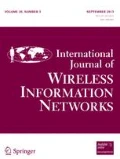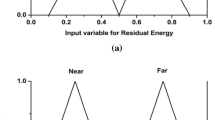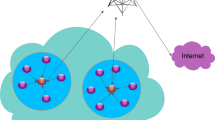Abstract
Energy efficiency and quality of service (QoS) are both required performances in the practical applications of wireless sensor networks. Clustering is one of main methods to achieve performance tradeoffs. In the clustering algorithm, the selection of the cluster heads is based on some criteria, which provides the opportunity to implement the performance tradeoffs. In this paper, a clustering algorithm based on fuzzy comprehensive evaluation method (CAFCE), is proposed to achieve both energy efficiency and QoS performance. Residual energy, location, number of neighbors, queue length and channel quality are taken into account as the factors that can influence the selection of cluster heads. Fuzzy comprehensive evaluation method is adopted to select appropriate cluster heads in order to achieve energy efficiency and QoS performance simultaneously. Each node obtains its own evaluation value. Then this value is mapped onto the time axis, and a time-trigger mechanism enables the node broadcast cluster head advertisement in the corresponding time slice. The rule of minimum transmission power is adopted to form the cluster. Simulation results denote that CAFCE algorithm has longer lifetime and better QoS performance than other algorithms.













Similar content being viewed by others
References
A. Chehri, and H.T. Mouftah, “QoS Aware Green Routing Protocol for Wireless Sensor Networks,” 2012 25th IEEE Canadian Conference on Electrical and Computer Engineering (CCECE), Montreal, QC, Canada, Apr 29–May 2, 2012.
F. Bajaber, I. Awan, An efficient cluster-based communication protocol for wireless sensor networks, Telecommunication Systems, vol. 55, no. 3, pp. 387–401, 2014, DOI 10.1007/s11235-013-9794-y.
S.C. Sansar, M.M. Gore, Balancing energy consumption across network for maximizing lifetime in cluster-based wireless sensor network, CSI Transactions on ICT, pp. 1–8, 2016, DOI 10.1007/s40012-015-0074-8.
S. Naeimi, H. Ghafghazi, C.O. Chow, H. Ishii, A Survey on the Taxonomy of Cluster-Based Routing Protocols for Homogeneous Wireless Sensor Networks, Sensors, vol. 12, no. 6, pp. 7350–7409, 2012.
G.N. He, S.Q. Zhang, Y. Chen, S.G. Xu, Fundamental Tradeoffs and Evaluation Methodology for Future Green Wireless Networks, 2012 1st IEEE International Conference on Communications in China Workshops, ICCC 2012, pp. 74–78, 2012.
X.F. Wang, A.V. Vasilakos, M. Chen, Y.H. Liu, T.T. Kwon, A survey of green mobile networks: Opportunities and challenges, Mobile Networks and Applications, vol. 17, no. 1, pp. 4–20, 2012.
F. Yu, W. Liu, G. Li, An Improved Cluster Head Algorithm for Wireless Sensor Network, 3rd International Conference on Computer Engineering and Network, CENet 2013, Shanghai, China, July 20–21, 2013, pp. 65–71, DOI 10.1007/978-3-319-01766-2-8.
N. Tuah, M. Ismail, K. Jumari, Cluster-Head Selection by Remaining Energy Consideration in a Wireless Sensor Network, International Conference, ICIEIS 2011, Kuala Lumpur, Malaysia, November 14–16, 2011, vol. 253, pp. 498–507, DOI 10.1007/978-3-642-25462-8_45.
W.B. Heinzelman, A.P. Chandrakasan, H. Balakrishnan, Energy-efficient communication protocol for wireless microsensor networks, Proceedings of the 33rd Annual Hawaii Intl Conference on System Sciences 2000, vol. 2, no. 10, pp. 3005–3014, 2000.
M.J. Handy, M. Haase, D. Timmermann, Low energy adaptive clustering hierarchy with deterministic cluster-head selection, Proceedings of the 4th IEEE Conference on Mobile and Wireless Communications Networks, pp. 368–372, 2002.
O. Younis, S. Fahmy, Heed: A hybrid, energy-efficient, distributed clustering approach for ad-hoc sensor networks, IEEE Transactions on Mobile Computing, vol. 3, no. 4, pp. 660–669, 2004.
M. Tong, LEACH-B: An improved LEACH protocol for wireless sensor network, 6th International Conference on Wireless Communications Networking and Mobile Computing (WiCOM), Shanghai, China, 2010.
X.N. Fan, Y.L. Song, Improvement on LEACH protocol of wireless sensor network, International Conference on Sensor Technologies and Applications, Sensor Comm, pp. 260–264, 2007.
M. Chatterjee, S.K. Das, D. Turgut, WCA: A weighted clustering algorithm for mobile Ad hoc networks, Journal of Cluster Computing, vol. 5, no. 2, pp. 193–204, 2002.
W.C. Choi, M. Woo, A Distributed Weighted Clustering Algorithm for Mobile Ad Hoc Networks, Advanced International Conference on Telecommunications and International Conference on Internet and Web Applications and Services (AICT-ICIWI06), pp. 73–78, 2006.
H.Q. Huang, D.Y. Yao, J. Shen, K. Ma, H.T. Liu, A Multi-weight Based Clustering Algorithm for Wireless Sensor Networks, Journal of Electronics & Information Technology, vol. 30, no. 6, pp. 1489–1492, 2008.
A.M. Ortiz, F. Royo, T. Olivares, J.C. Castillo, L. Orozco-Barbosa, P.J. Marron, Fuzzy-logic based routing for dense wireless sensor networks, Telecommunication System, vol. 52, no. 4, 2687–2697, 2013.
I. Gupta, D. Riordan, S. Sampalli, Cluster-Head election using fuzzy logic for wireless sensor networks, Proceedings of the 3rd Annual Communication Networks and Services Research Conference, 255–260, 2005.
T. Gao, R.C. Jin, J.Y. Song, T.B. Xu, L.D. Wang, Energy-Efficient Cluster Head Selection Scheme Based on Multiple Criteria Decision Making for Wireless Sensor Networks, Wireless Personal Communications, vol. 63, no. 4, pp. 871–894, 2012.
J.M. Kim, S.H. Park, Y.J. Han, T.M. Chung, CHEF: Cluster Head Election mechanism using Fuzzy logic in wireless sensor networks, 10th International Conference on Advanced Communication Technology, ICACT2008, 1, 654–659, 2008.
J. Annoa, L. Barollib, A. Durresic, F. Xhafad, A. Koyamae, Performance evaluation of two fuzzy-based cluster head selection systems for wireless sensor networks, Mobile Information Systems, vol. 4, pp. 297–312, 2008.
J. Annoa, L. Barolli, F. Xhafa, A. Durresi, A cluster head selection method for wireless sensor networks based on fuzzy logic, IEEE Region 10 Annual International Conference, TENCON 2007, vol. 1–3, pp. 833–836, 2007.
X.H. Xue, X.G. Yang, Seismic liquefaction potential assessed by fuzzy comprehensive evaluation method, Natural Hazards, vol. 71, no. 3, pp 2101–2112, 2014, DOI 10.1007/s11069-013-0997-z.
J. Hou, S.K. Zhang, Y.H. Zhang, R.R. Wang, F.Q. Luo, Prediction of Microscopic Remaining Oil Distribution Using Fuzzy Comprehensive Evaluation,Transp Porous Med (2011) 89:533C545, DOI 10.1007/s11242-011-9784-z.
L. Han, Y.H. Song, L. Duan, P. Yuan, Risk assessment methodology for Shenyang Chemical Industrial Park based on fuzzy comprehensive evaluation, Environmental Earth Sciences, vol. 73, no. 9, pp 5185–5192, 2015, DOI 10.1007/s12665-015-4324-8.
Y.R. Zhang, J. Zhang, Y.D. Li, C. Ji, The Application of Fuzzy Comprehensive Evaluation on Special Equipment Risk Assessment, The 19th International Conference on Industrial Engineering and Engineering Management, pp 1175–7784, 2013, DOI: 10.1007/978-3-642-38433-2_123.
S. Bandyopadhyay, E.J. Coyle, An energy efficient hierarchical clustering algorithm for wireless sensor networks, Twenty-second Annual Joint Conference of the IEEE Computer and Communications Societies-IEEE INFOCOM, San Francisco, CA, USA, 2003, vol. (1–3), pp. 1713–1723, 2003.
Acknowledgements
This work was funded in part by a Grant from National Natural Science Foundation of China No. 5307012. This work was also partly supported by the fund of the general program of Liaoning Provincial Department of Education Science Research, No. L2013210 and the Dalian Polytechnic University Youth Grants, No. QNJJ201307.
Author information
Authors and Affiliations
Corresponding author
Rights and permissions
About this article
Cite this article
Gao, T., Song, JY., Ding, JH. et al. Clustering Algorithm Based on Fuzzy Comprehensive Evaluation for Wireless Sensor Networks. Int J Wireless Inf Networks 24, 1–13 (2017). https://doi.org/10.1007/s10776-016-0324-1
Received:
Accepted:
Published:
Issue Date:
DOI: https://doi.org/10.1007/s10776-016-0324-1




